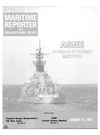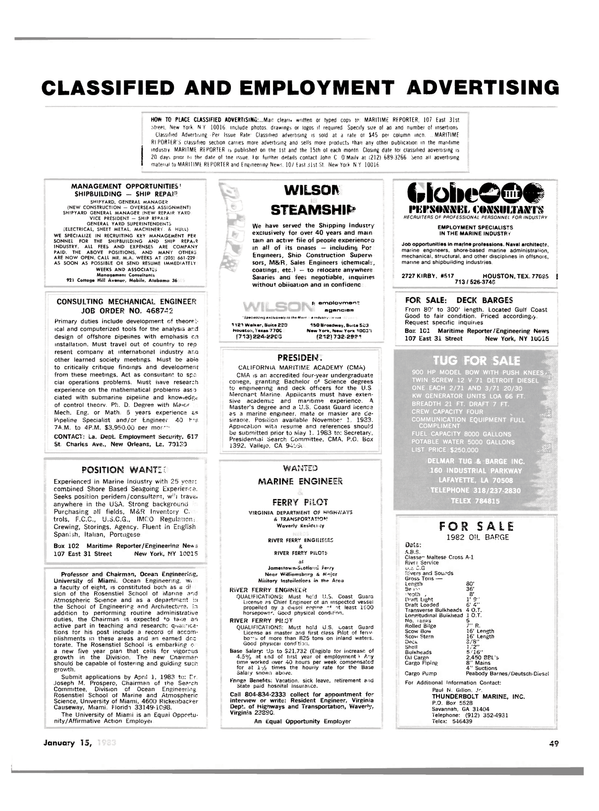
Deep-Notch Tug And Barge Delivered To Energy Transportation
Energy Transportation Corporation of New York City has taken delivery of a tug and 420- foot notched-stern barge for the transportation of liquefied ammonia in the Gulf Coast area.
The tug/barge will be operated by Energy Ammonia Transportation Corporation, a subsidiary, under long-term time charter to International Minerals & Chemical Corporation.
The barge Energy Ammonia was constructed in two phases.
The steel structure and deck machinery were built at the Modec Louisiana Shipyard in LaRose, La., in 1981. It was then towed up the Mississippi to Memphis, Tenn., where the trunk deck was removed, cargo tanks constructed, insulated, and installed, and a cargo-handling system installed by Chicago Bridge & Iron Company.
The cargo system was tested following a tow down the Mississippi to the Baton Rouge area where the barge met the tug Energy Altair and loaded its first cargo of ammonia for delivery to the International Minerals & Chemical Corporation terminal in Tampa, Fla. It is unmanned and the cargo liquefaction system is designed for fully automatic operation.
The Energy Ammonia is 420 feet long, with a beam of 78 feet, and a depth to the main deck of 28 feet. The notch is 48 feet long.
The tug Energy Altair was built by Bollinger Machine Shop and Shipyard, Lockport, La. Its principal c h a r a c t e r i s t i c s are: length, 120 feet; beam, 37 feet; and depth, 18 feet. The tug is equipped to push when set in the deep notch of the barge or tow on a hawser.
Accommodations are provided for 11 people and the vessel is equipped with an upper and lower pilothouse. The upper pilothouse is used when in the notch and the barge is light to attain proper visibility. The lower pilothouse is used when in the notch and the loaded barge's draft allows proper visibility or when towing on a hawser.
Both pilothouses are equipped with a gyrocompass, radar, Loran C, VHF radio, depth sounders, searchlights, and in addition the lower pilothouse has a satellite navigation unit and a singlesideband radio.
Two 12-cylinder ALCO diesel engines coupled to Reintjes 5 to 1 reverse reduction gears provide propulsion power. They drive 108-inch-diameter propellers with fixed Kort nozzles. Twin rudders, fitted behind each propeller, are powered by hydraulic steering gear to improve steering and permit shaft withdrawl without removing the rudders. Total propulsion brake horsepower is 4,860 maximum.
There are two 99-kw, 230-V, 3-phase generators driven by 8Y- 71 Detroit Diesel engines. Each unit is capable of supplying all power requirements for the auxiliary equipment and house electrical loads.
Deck equipment consists of a 160,000-pound line pull towing winch driven by a 6V-71 Detroit Diesel equipped with 2,400 feet of 2-inch wire rope and an auxiliary drum; a 1,000-pound stockless anchor and anchor windlass; and a deck capstan on the aft deck for handling tow gear. The bilge/ballast and fire systems piping are all interconnected with a Barnes 25ICU-1 pump servicing each system. Separate manifolds for the bilge system and ballast system are located in the engine room. Five fire stations are located two in the engine room; one main deck (port side) ; one fo'c'sle deck (stbd. side) ; and one upper deck (port side). Each fire station has 50 feet of hose and a combination stream/fog nozzle.
Read Deep-Notch Tug And Barge Delivered To Energy Transportation in Pdf, Flash or Html5 edition of January 15, 1983 Maritime Reporter
Other stories from January 15, 1983 issue
Content
- Aalborg Vaerft Conducts Tank Tests Of New Cruise Liner Model page: 6
- Thomas Marine Delivers Two 38-Foot Police Patrol Boats page: 8
- Todd Pacific Delivers Guided Missile Frigate Reid To The U.S. Navy page: 8
- Kone And Far East-Levingston In Joint Venture For Crane Manufacturing In Singapore page: 10
- CSSRA Urges Adoption Of Canadian Building Policy page: 10
- Leevac Corporation Names Terry Hardouin Planning Manager page: 10
- Tidewater Marine Buys T1 Vessels From Halter Marine For $33 Million page: 11
- A.S.N.E. PUTTING FIRE POWER TO SEA page: 12
- Elliott Awarded Additional Contract For Thruster Unit page: 15
- Roger Ffooks Appointed European Representative For J.J. Henry Firm page: 15
- Battleship New Jersey Is Recommissioned page: 16
- Norshipco's Floating Drydock Titan' Aids In Tunnel Construction Project page: 16
- Aeroquip Names Manager, Contract Administration, For M a r i n e / M i l i t a r y Products page: 17
- Two Ro/Ro's For Saudi Arabia Dedicated At Kockums, Four-Ship Order Valued At $250 Million page: 17
- Navy Civil Engineering Lab Completes Studies On Future Pier Designs page: 18
- New Marine Insurance Brochure Available From Skuld In Norway page: 18
- Dravo Appoints Three Senior Officials In Its Marine Construction Organization page: 19
- $32.6-Million Title XI Sought For Purchase And Rebuilding Of RO/RO page: 19
- SKF Couplings Described In Free 26-Page Full-Color Brochure page: 19
- Joseph Farrell Selected As New AWO President page: 20
- Navy Awards $1.87-Million Crane Contract To Clyde page: 20
- Ship Model Basin Dedicated At N.Y. State Maritime College page: 20
- New Ferry Contract For Over $1-Million Awarded To Offshore Shipbuilding page: 21
- Lykes Ship Sends Data By Satellite-Phone Hookup page: 21
- Oceans '83 Conference Issues Call For Papers page: 21
- Nichols Brothers Yard Starts Work On 265-Foot Split-Hull Hopper Dredge page: 21
- Ehrenfried Of Metritape Presents Paper At SNAME New England Meeting page: 21
- MAN-B&W Diesel Holds Symposium For West Coast Marine Industry Leaders page: 22
- Bruce D. Smith Elected President Of COMSAT Technology Products page: 22
- MacGregor To Equip 30 Barges, 3 Ships Building In Japan For Paraguay page: 22
- Barber President Named Commissioner Of Pilots page: 35
- Bates To Retire As ACL Chairman At End Of '83, —Koch Named Successor page: 35
- $ 5 . 4 - M i l l i o n Navy Contract A w a r d e d Tracor For SSBN Sonar Systems Services page: 36
- Romanelli Joins Fairhaven M a r i n e As Vice President page: 36
- Kelly Named Vice President Of Lykes Pacific Division page: 37
- M a r A d Offers Report On Shipboard Fuel Handling And Conditioning page: 37
- New 15-100 H.P. Barge Spotters Described In Free Literature page: 37
- Lockheed To Build Prototype Vehicles To*' Destroy Naval Mines page: 38
- Coast Guard Publishes Revised Navigation Rules page: 39
- Johnson & Towers Named Alco Diesel Distributor —Literature Offered page: 39
- ASNE Southern New England Discusses Sub Combat Systems page: 41
- MarAd Approves Crowley Acquisition Of Delta Steamship Stock For $96 Million page: 42
- LTI Introduces New System For M o v i n g Ship Sections —Literature A v a i l a b le page: 43
- SNAME-Philadelphia Section Hears Paper On Marine Epoxy Resin Chocks page: 44
- Trellclean Conducts Technical Briefing And Hull-Cleaning Demonstration page: 44
- Uniflite Announces Three Executive Appointments page: 45
- Deep-Notch Tug And Barge Delivered To Energy Transportation page: 45
- Jackup Rig "Sam Noble" Is Christened At Levingston page: 46
- New USCG Pollution Prevention Requirements Effective October 2 page: 46
- Stone Manganese Offers Technical Reports On Fuel Economy And Propellers page: 48
- Burton Delivers 224-Foot Seiner, Sixth Of Seven Foir Van Camp page: 48
- Pan-American Naval Engineers To Hold 1983 Meeting in D.C. page: 48
- Paceco Delivers Railmounted Transtainer Crane To U.S. Army page: 53
- Hoffert Manufacturing Awards Caribbean Cruise At SNAME Exposition page: 58
- Nome Seeks $38.5-Million For Proposed Year-Round Port page: 58
- Bay Shipbuilding Retains W i l l i am Thompson As Washington Representative page: 59
- Bulk Carrier Karnataka Undergoes Repairs, Modernization At HUD page: 59
- Dravo Launches Coastal Hopper Barge For C.G. Willis page: 59


